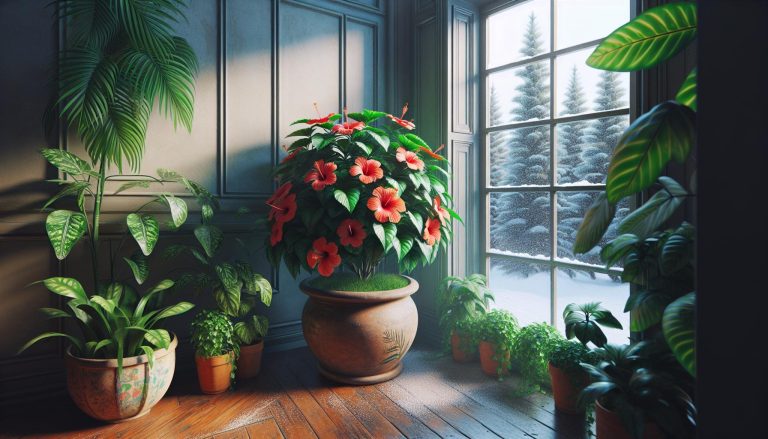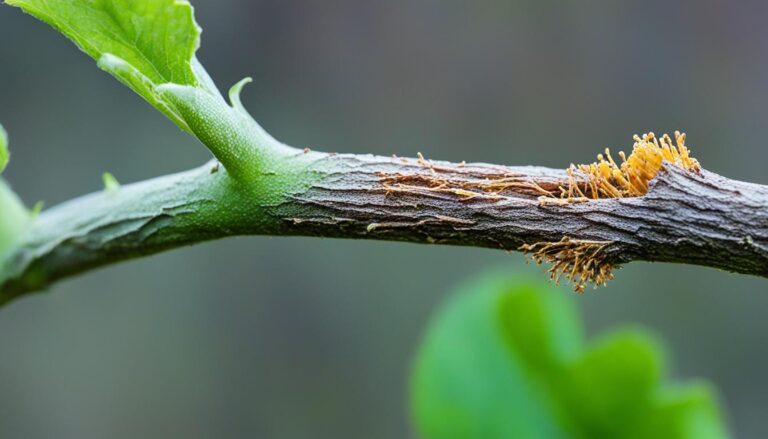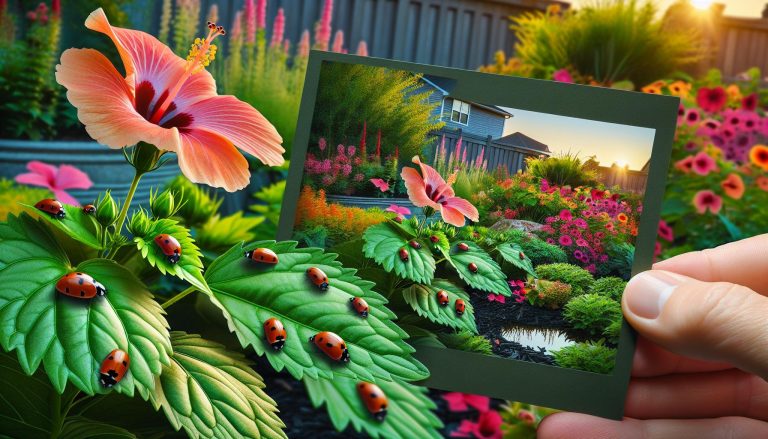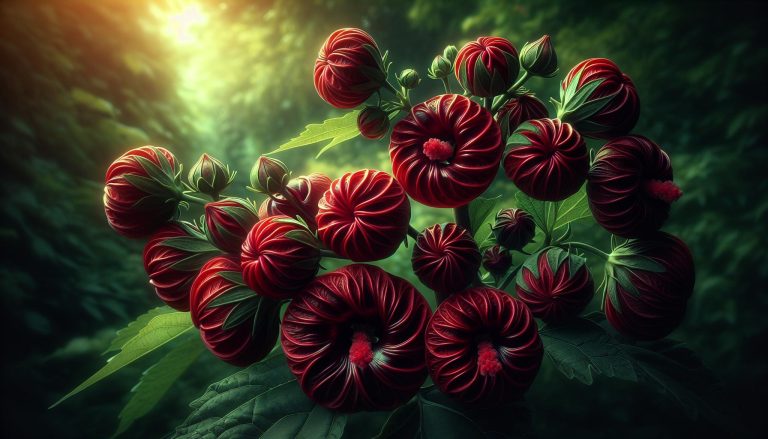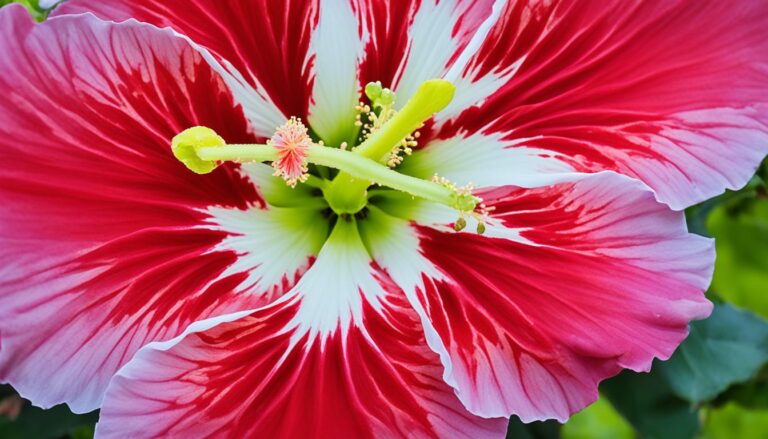Rose of Sharon vs Hibiscus: Blooms, Care, and Design Tips
In the vibrant world of gardening, the allure of the Rose of Sharon and the Hibiscus captivates us with their stunning blossoms and lush foliage.
Both belonging to the same family, they share similarities that often lead to confusion among enthusiasts. Yet, each plant holds its unique charm and specific requirements that set them apart.
As we delve into the nuances of the Rose of Sharon versus Hibiscus, we’ll uncover the distinct characteristics that make each plant a standout choice for gardeners seeking to add a splash of color to their landscape.
From the award-winning Blue Chiffon® to the towering Purple Pillar®, these varieties offer a glimpse into the diverse world of Hibiscus syriacus.
With their ability to thrive in various zones and their minimal care requirements, they’re not just plants but a testament to the beauty and resilience of nature.
Join us as we explore the differences and similarities between these two beloved plants, guiding you to make the best choice for your garden oasis.
Key Takeaways
- Rose of Sharon vs. Hibiscus Similarities and Differences: Both Rose of Sharon and Hibiscus belong to the Malvaceae family, sharing a botanical kinship. While Rose of Sharon thrives as a hardy shrub with woody growth, Hibiscus is known for its larger, tropical flowers. Understanding their distinct appearances and growth habits enables gardeners to choose the right plant for their landscape aesthetics and conditions.
- Growth Requirements and Care: Both plants prefer full sun exposures and well-draining soil to flourish, thriving in USDA zones 5-9. While Roses of Sharon are low maintenance with minimal required pruning, Hibiscus benefits from light pruning for bushier growth and more blooms. Regular watering and proper fertilization are key for health and flower production.
- Coping with Pests, Diseases, and Cultivation Challenges: Aphids, spider mites, and whiteflies are common pests for these plants, with fungal diseases like rust and botrytis blight also posing threats. Timely pest control measures, appropriate watering, and soil management are critical to prevent yellow leaves and promote blooming.
- Seasonal Insights and Bloom Time: Rose of Sharon typically blooms from late spring through fall, while Hibiscus’s bloom period depends on the variety, with some flowering year-round in ideal conditions. Understanding and planning for their dormancy and winter behavior can ensure vitality and readiness for the subsequent blooming season.
- Cultivar Selection for Landscape Success: Choosing the right cultivar involves considering factors such as sterility versus seed production and
Understanding Rose of Sharon and Hibiscus
The Botanical Connection
Embarking on a journey through the world of flora, it’s fascinating to discover the botanical relationships between various plants.
When it comes to Rose of Sharon and Hibiscus, the connection runs deep, with both plants sharing membership in the same botanical family, Malvaceae.
This family resemblance ties them together, offering a shared heritage that contributes to their captivating beauty. Varieties like the Blue Chiffon® and Purple Pillar® align under the Hibiscus syriacus species, showcasing the diversity within this splendid family.
Their shared lineage sparks a curiosity that leads us to further explore and appreciate the unique attributes and versatile applications of these plants in our gardens.
Key Differences in Appearance
While Rose of Sharon and Hibiscus share a botanical kinship, our exploration reveals striking differences in appearance that distinguish these garden favorites.
The Rose of Sharon, characterized by its woody growth habit, exhibits a shrub-like form, producing an array of colors from lavender to magenta. Its blossoms, often featuring a double layer of petals, are reminiscent of a classic English garden aesthetic.
In contrast, the tropical Hibiscus is celebrated for its larger, more flamboyant flowers, which come in a vibrant palette of colors, including bold reds, yellows, and pinks.
These flowers, often single, make a bold statement in containers and landscapes, exuding a tropical charm that’s hard to overlook.
The distinct growth habits of each plant – the Rose of Sharon’s shrub-like stature versus the Hibiscus’s lush, leafy presence – further underscore the visual distinctions that set them apart in the garden.
By understanding these differences, we can appreciate not only their shared botanical roots but also the distinct characteristics that make each plant uniquely suited to different gardening styles and preferences.
This insight allows us to better plan our garden spaces, ensuring each plant thrives and brings its unique beauty to our outdoor sanctuaries.
Growth and Care

Ideal Growing Conditions
When it comes to growing Roses of Sharon and Hibiscus plants, ensuring they’re placed in the right conditions is key to witnessing their stunning floral display.
Both plants thrive in USDA zones 5-9, showing their resilience and adaptability across various climates. However, their cultivation success hinges on meeting specific environmental conditions.
For Roses of Sharon and Hibiscus, full sun exposure is crucial. These plants flourish under direct sunlight, which bolsters flower production and stem strength.
Although they can tolerate partial afternoon shade, the blossoms and overall plant vigor are most pronounced when basked in sunlight.
Importantly, good air circulation around the plants prevents potential disease issues, contributing to a healthier growth.
The soil’s quality also plays a pivotal role in their care. These plants aren’t fussy about the soil type but insist on well-draining conditions.
High fertility levels can aid in robust growth and blooming, but what’s imperative is avoiding waterlogged soil that can lead to root issues.
When watering, aim for consistency, providing enough moisture to keep the soil damp but not soggy, promoting optimal health and flower development.
Pruning and Maintenance
Our Roses of Sharon and Hibiscus not only delight with their beauty but also with their low maintenance nature, particularly when it comes to pruning.
Roses of Sharon, for the most part, requires no pruning, which simplifies garden care tremendously. However, if one desires to shape the plant or manage its size, we recommend pruning in early spring.
It’s important to remember not to trim more than one-third of the plant in a single season to avoid stress and damage.
On the other hand, Hibiscus plants, including varieties like Blue Chiffon® and Purple Pillar®, benefit from light pruning to encourage bushier growth and more blooms.
The ideal time for this is also in early spring, before the new growth starts. This practice not only helps to maintain a desired shape but also removes any dead or weakened parts of the plant, fostering a stronger and healthier specimen.
Regardless of variety, both Roses of Sharon and Hibiscus respond well to granular rose fertilizers applied in early spring, fueling their growth and flowering capabilities.
Yet, it’s crucial to halt fertilization as fall approaches to prevent tender new growths that won’t survive the winter.
By understanding and applying these growth and care guidelines, gardeners can ensure their Roses of Sharon and Hibiscus plants achieve their full majestic potential, becoming breathtaking highlights in any garden space.
Cultivation Challenges

Common Pests and Diseases
In our journey of cultivating Roses of Sharon and Hibiscus, we encounter a few bumps along the way, particularly with pests and diseases that can hinder their growth.
Aphids, spider mites, and whiteflies are common pests that target these plants, especially during the warmer months. These small but mighty creatures feed on the sap of the plants, weakening them and potentially spreading diseases.
Additionally, both Roses of Sharon and various Hibiscus species are susceptible to fungal diseases like rust, leaf spot, and botrytis blight.
These diseases manifest as discolored spots on leaves and blooms, which can lead to premature leaf drop and a decline in overall plant vigor.
To combat these issues, we recommend regular inspection of your plants for early signs of pests and diseases.
Applying insecticidal soap or neem oil can effectively control pest infestations, while fungicidal sprays may be used to manage fungal diseases.
It’s also important to maintain cleanliness around the plants, as fallen leaves and debris can harbor pests and fungi.
Addressing Yellow Leaves and Non-Blooming Issues
Encountering yellow leaves and non-blooming situations are common cultivation challenges that can be quite frustrating.
These issues often signify that the plant is under stress or not receiving its optimal care requirements.
Yellow leaves can result from a variety of factors, including water stress (either too much or too little), soil pH imbalance, nutrient deficiencies, or poor drainage.
Ensuring that Roses of Sharon and Hibiscus are planted in well-draining soil and receive regular, but not excessive, watering can help prevent yellow leaves.
Testing your soil and amending it as needed to achieve a neutral to slightly acidic pH can also alleviate this issue.
Non-blooming, on the other hand, might occur due to insufficient sunlight, over-fertilization, or improper pruning. Both Roses of Sharon and Hibiscus thrive in full sun, receiving at least 6 to 8 hours of direct sunlight daily.
If your plant is in a shaded area, consider relocating it to a sunnier spot. Additionally, be careful with fertilization; too much nitrogen can result in lush foliage at the expense of blooms.
Lastly, if you’re pruning these plants, do so at the correct time of year—early spring for Roses of Sharon and after blooming for other types of Hibiscus—to avoid cutting off the current or upcoming season’s blooms.
By understanding and addressing these cultivation challenges, we can help our garden’s Roses of Sharon and Hibiscus plants flourish, offering their full potential of beauty and color to our outdoor spaces.
Seasonal Insights

As we delve into the seasonal aspects of Roses of Sharon and Hibiscus plants, it’s essential to understand how these beauties transition through the year.
Here, we’ll examine their bloom times and how they behave in winter, providing insights to help you plan your garden for continuous color and interest.
Bloom Time Comparison
Roses of Sharon and Hibiscus plants share the spotlight when it comes to their flowering season, but they do have some differences in timing that can be crucial for garden planning.
Typically, the Rose of Sharon, a type of Hibiscus syriacus, begins its bloom cycle in late spring and continues through until the first frosts of fall.
This enduring bloom period ensures a splash of color in the garden when many other plants have finished their display.
On the other hand, traditional Hibiscus varieties, especially those in tropical regions, can have a more extended bloom period, depending on their environment.
In ideal conditions, they can flower year-round, but more commonly, their peak bloom occurs in the summer months.
This characteristic makes them perfect companions to the Rose of Sharon, ensuring that our gardens remain vibrant and colorful throughout the warmer seasons.
Winter Behavior: Leaf Drop and Dormancy
As gardeners, understanding the winter behavior of our plants is key to ensuring their survival and bloom readiness for the next season.
Both Roses of Sharon and Hibiscus plants experience leaf drop as they enter dormancy, a normal part of their lifecycle in response to colder temperatures.
For the Rose of Sharon, leaf drop signifies the beginning of a dormancy period that lasts through the winter. During this time, it’s crucial that we provide them with the care they need to weather the cold, including mulching around the base to protect the roots and reduce water loss.
Hibiscus plants, especially tropical varieties, can be more sensitive to cold temperatures. In regions with mild winters, they may retain some of their foliage, but in colder areas, they might lose all their leaves and require protection or indoor shelter to survive until spring.
Ensuring they are planted in a sunny, sheltered spot can help minimize winter damage and facilitate a quicker recovery once warmer temperatures return.
By understanding these seasonal behaviors and planning accordingly, we can enjoy the spectacular blooms of both Roses of Sharon and Hibiscus plants, making our gardens a year-round retreat for the senses.
Cultivar Considerations
When exploring the world of Roses of Sharon and Hibiscus plants, cultivar selection becomes an essential step in planning a garden.
Selecting the right variety can significantly influence the garden’s ecosystem, maintenance level, and aesthetic appeal.
Let’s delve into some critical considerations regarding sterility, seed production, and the adaptability of these plants to pot cultivation.
Sterility and Seed Production
One crucial aspect when choosing between Rose of Sharon and Hibiscus cultivars is sterility and seed production. Varieties like the ‘Blue Chiffon’ Rose of Sharon have been bred for their stunning flowers and low seed production.
This characteristic means less worry about the plant self-seeding and potentially becoming invasive in the garden.
Gardeners often prefer sterile cultivars because they tend to put more energy into flower production, resulting in a longer and more vibrant blooming season.
On the other hand, some gardeners may choose non-sterile varieties for their ability to produce seeds.
These seeds can be collected for propagation or left to self-seed in the garden, giving rise to new plants in subsequent seasons.
However, it’s essential to monitor these volunteers to ensure they don’t crowd out other garden plants or become a nuisance.
Varietal Size and Pot Cultivation
Considering varietal size and its implications for pot cultivation is another critical factor in cultivar selection.
The ‘Purple Pillar’ Rose of Sharon, for example, grows tall and narrow, making it an excellent choice for those looking to add privacy or vertical interest without taking up too much horizontal space.
This unique growth habit also makes it suitable for container gardening, where space is at a premium.
Container gardening with Roses of Sharon and Hibiscus allows for greater control over the growing conditions, including soil type, water, and nutrients.
Moreover, pots provide the flexibility to move plants around to achieve the perfect garden design or to protect them in adverse weather conditions.
When choosing varieties for pot cultivation, consider their mature size and root system to select a container that accommodates their growth without frequent repotting.
Selecting the right cultivar of Rose of Sharon or Hibiscus involves considering factors like sterility, seed production, and suitability for pot cultivation.
These considerations help gardeners create a garden that matches their aesthetic preferences, maintenance capabilities, and space limitations, ensuring a beautiful and manageable garden landscape.
Environmental Considerations
Shade Tolerance and Deer Resistance
When planning a garden, understanding how different plants interact with their environment ensures a thriving ecosystem.
Roses of Sharon exhibit remarkable resilience in a variety of light conditions, though they flourish best in full sun.
They can tolerate partial shade, making them versatile additions to landscapes where sunlight may be filtered through trees.
This adaptability makes planning a garden with a mix of light exposures easier, ensuring that each plant receives the proper amount of sunlight it needs to thrive.
Deer resistance is another crucial factor for gardeners in areas where deer are prevalent. Luckily, Roses of Sharon are fairly deer resistant, according to Rutgers’ landscape plants rated by deer resistance list.
They receive a B rating, meaning they are seldom severely damaged. This makes them an excellent choice for areas where deer browsing can be a problem, reducing the need for protective measures and allowing the garden to maintain its aesthetic appeal without constant surveillance.
Toxicity Concerns for Pets
For pet owners, ensuring the safety of their furry friends while designing a garden is paramount. It’s a relief to know that Roses of Sharon are not toxic to dogs, cats, or horses, as indicated by the ASPCA.
This characteristic is incredibly important for gardens accessible to pets, providing peace of mind that the plantings will not harm curious animals that might nibble on the plants.
Gardeners can confidently include Roses of Sharon in their landscapes, knowing their beauty does not come with a risk to pet health.
This allows for a wider variety of plant options and creates a safe environment for all household members, fostering a harmonious living space for plants, pets, and people alike.
Landscape and Garden Use

Utilizing Rose of Sharon in Landscaping
Incorporating Rose of Sharon into landscaping offers a versatile and vibrant solution for various garden settings.
Known for its late-summer blooms, this plant can become the focal point of a mixed shrub border or a stunning specimen at the end of a long vista.
Its height and deciduous nature make Rose of Sharon ideal for creating a living screen during the growth season, though it’s important to remember its screening effect disappears in winter.
Gardeners can plant Rose of Sharon shrubs as a formal hedge, trimming them to maintain shape, or let them grow naturally to form the backdrop for a pollinator garden.
Their fairly deer-resistant qualities, as indicated by Rutgers’ B rating, mean that they’re less likely to suffer severe damage in areas where deer are common.
Moreover, Rose of Sharon loves sunlight, thriving in locations that receive at least eight hours of bright light daily, although they can tolerate part shade.
For those interested in supporting local ecosystems, planting Rose of Sharon can contribute positively, especially when incorporating native varieties into the garden.
This plant’s adaptability to full sun or partial shade, alongside its moisture and well-drained soil preference, ensures it integrates well into many garden designs without requiring extensive care.
Hibiscus in Garden Design
Hibiscus plants, with their tropical flair and large, colorful blooms, add striking visual interest to any garden design.
Gardeners can use hibiscus to ‘transport’ a tropical vibe right to their backyard, as these plants are among the most vibrant landscape elements available.
Hibiscus varieties like Blue Chiffon, with its fluffy-centered flowers and Blue Chiffon award, or Purple Pillar, recognized as the 2023 National Landscape Shrub of the Year, showcase the plant’s diversity in color and form.
While traditionally grown as multi-trunked shrubs, hibiscus can also be trained as a single-trunk small tree or in espalier form, offering flexibility in landscape design.
The plant’s requirement for full to partial sun aligns with its need for well-drained soil, making it a suitable option for gardeners looking to anchor structures to the landscape or use them as foundation plants.
It’s important to note, however, that certain hibiscus varieties can be invasive in certain areas. Gardeners should assess their local environment and consider non-invasive or native hibiscus varieties that contribute to biodiversity without displacing native flora.
When properly selected and placed, hibiscus can serve as an excellent foundation plant, enhancing garden aesthetics without overwhelming the area or clashing with existing tones.
Both Rose of Sharon and hibiscus offer unique benefits and challenges in landscape and garden design. By understanding their growth habits, seasonal behaviors, and environmental impact, gardeners can make informed decisions to incorporate these beautiful plants into their outdoor spaces effectively.
Final Words
We’ve journeyed through the enchanting world of Rose of Sharon and Hibiscus, uncovering their unique charms and challenges.
Armed with insights on their care, bloom cycles, and landscape uses, we’re better equipped to make our gardens a haven of color and life.
Whether it’s the stately presence of Rose of Sharon or the tropical allure of Hibiscus that captures your heart, both plants promise to transform your garden into a vibrant oasis.
Let’s embrace their beauty and versatility, creating outdoor spaces that thrive and inspire. Happy gardening!
Frequently Asked Questions
Should I deadhead my rose of Sharon?
There’s no need to deadhead rose of Sharon.
After three years (or when it’s reached a height of around 1.5m), start pruning your rose of Sharon annually to keep in shape.
If left unpruned, the outer branches can fall outwards from the weight of the leaves.
Why is Rose of Sharon invasive?
Hibiscus syriacus can be somewhat aggressive in its growth, as it self-seeds prolifically.
In certain conditions and regions, this self-seeding ability can lead to unwanted spread and establishment in natural habitats, potentially leading to it being seen as invasive.
Do hummingbirds like Rose of Sharon hibiscus?
Rose of Sharon, Hibiscus syriacus, isn’t a rose, but its large, flat blossoms and nectar attract hummingbirds and tiny insects that hummers also eat.
The flowers on this woody shrub come in several colors, including white, pink, purple, and red.
What are the cons of rose of Sharon?
In the past, rose of Sharon shrubs were known to drop seeds that sprouted everywhere, which was a nuisance in some lawns and gardens.
Modern breeders have gotten around that problem by developing seedless varieties or plants with few viable seeds.
What is the lifespan of a rose of Sharon bush?
These shrubs are vigorous, hardy plants with few pest or disease problems with an average life span of 20-30 years.
It could be that a few of your branches have succumbed to winter kill. Rose of Sharon prefers full sun, soil that is rich and moist, and is hardy to USDA zone 5 (i.e. Canadian zone 6).


